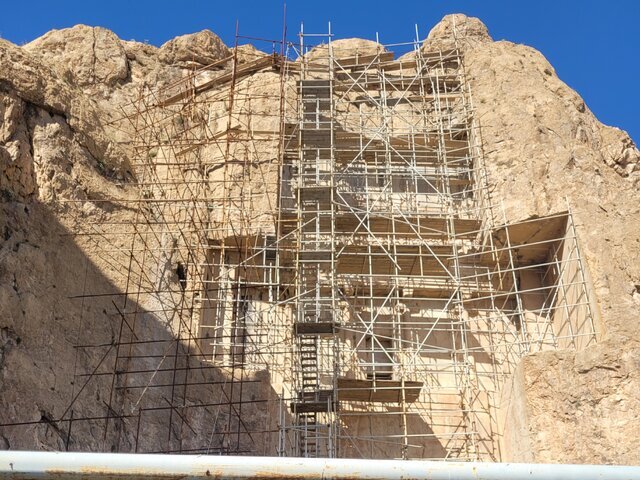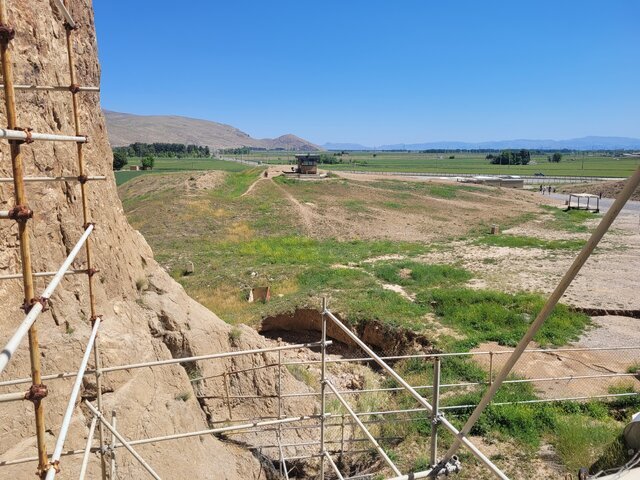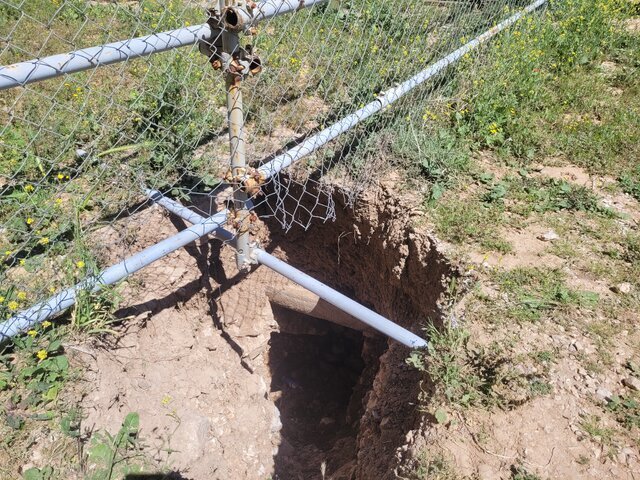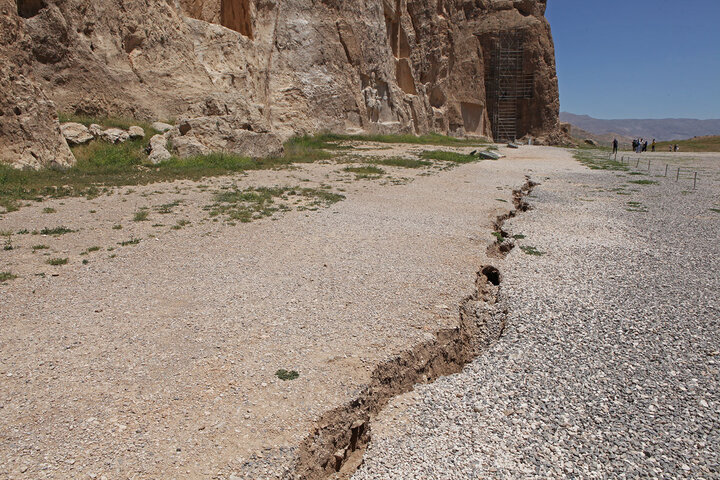Xerxes tomb at Naqsh-e Rostam faces erosion threats

TEHRAN - Recent rains have created a relatively large hole below Xerxes I's rock-cut tomb, leading to a longitudinal crack across the Naqsh-e Rostam site.
Evidence suggests erosion and water infiltration pose serious threats to the rock-cut tomb, which is currently under restoration, ISNA reported on Saturday.
Despite this, the director of the Persepolis World Heritage site, located nearby, believes that the erosion around the treasured royal tomb is manageable and can be resolved.
Speaking to ISNA, Alireza Askari Chaverdi, who is responsible for the Naqsh-e Rostam archaeological site, pointed out that several fallen stones have been accumulated in front of Xerxes' tomb.
“Inside the hole, a mysterious structure has been revealed, which has not yet been archaeologically studied but is speculated to be related to a water channel of Naqsh-e Rostam,” he said.

The official said what is particularly concerning are the large and deep holes formed below Xerxes' tomb, with cracks extending to the other nearby tombs where Darius the Great, Artaxerxes I, and Darius II have been laid to rest. “In addition, inside Xerxes' tomb chamber, numerous cracks and holes caused by water infiltration have been observed.”
Concerning potential threats to this historical site, he said an ancient settling basin above Xerxes' tomb has long ceased to function.
“The rainwater, which should have been collected in this basin, now cascades down with rock debris, accumulating in front of the tomb.”

This archaeologist added that because the water channels at Naqsh-e Rostam have lost their functionality, the water from this waterfall has found its way underground, creating deep holes.
“The more concerning issue is that it is unknown where the rainwater from the mountain is going.”
What is happening around Xerxes I's tomb and Naqsh-e Rostam is dangerous because the water could be damaging structures that archaeologists believe are still buried, Askari Chaverdi explained.
Talking about potential dangers to Xerxes' tomb and other structures at Naqsh-e Rostam, he said: since the water channel has lost its function, the overflowing water has penetrated the ground, damaging the walls of Naqsh-e Rostam. Therefore, the settling basin above the mountain must be restored first, the rock falls must be prevented, and the ancient water channels from the Achaemenid and Sassanian periods must be located to redirect water out of Naqsh-e Rostam as in the past.
To protect Xerxes' tomb near the waterfall, the archaeologists emphasized that the settling basin needs to be restored and archaeologically excavated to prevent the volume of rock from the waterfall from entering the Naqsh-e Rostam site (the area around Xerxes' tomb).

One of the wonders of the ancient world, Naqsh-e Rostam, which bears an array of scenic Sassanid bas-relief carvings, is situated near the UNESCO-designated Persepolis.
The necropolis embraces four tombs where Persian Achaemenid kings are laid to rest, believed to be those of Darius II, Artaxerxes I, Darius I, and Xerxes I (from left to right facing the cliff), although some historians are still debating this.
There are stunning bas-relief carvings above the tomb chambers that are similar to those at Persepolis, with the kings standing on thrones supported by figures representing the subject nations below. There are also two similar graves situated on the premises of Persepolis, probably belonging to Artaxerxes II and Artaxerxes III.

Beneath the funerary chambers are dotted with seven Sassanian era (224–651) bas-reliefs cut into the cliff depict vivid scenes of imperial conquests and royal ceremonies; signboards below each relief give a detailed description of English.
At the foot of Naqsh-e Rostam, in the direction of the cliff face, stands a square building known as Ka’beh-ye Zardusht, meaning Kaaba of Zoroaster. The building, which is roughly 12 meters high and 7 meters square, was probably constructed in the first half of the 6th century BC, although it bears a variety of inscriptions from later periods.

Though the Ka’beh-ye Zardusht is of great linguistic interest, its original purpose is not clear. It may have been a tomb for Achaemenian royalty or some sort of altar, perhaps to the goddess Anahiti, also called Anahita, believed to be associated with royalty, war, and fertility.
Naqsh-e Rostam, which literally means “Picture of Rostam”, is named after a mythical Iranian hero who is most celebrated in Shahnameh and Persian mythology. Back in time, natives of the region had erroneously supposed that the carvings below the tombs represented depictions of the mythical hero.
In Western history, Xerxes is best known for his invasion of Greece in 480 BC. Son of Darius the Great, he consolidated his power by crushing revolts in Egypt and Babylon, and renewed his father's campaign to subjugate Greece and punish Athens and its allies for their interference in the Ionian Revolt.
AM
Leave a Comment